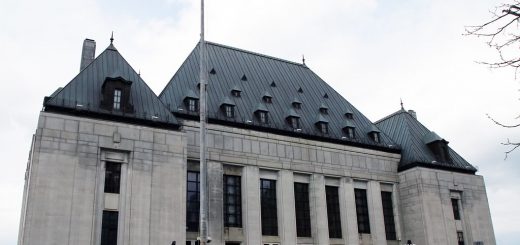R. v. Tim: SCC Upholds Convictions Despite Unconstitutional Search

In R v Tim, 2022 SCC 12 [Tim], the Supreme Court of Canada (“SCC” or “the Court”) affirmed convictions for drug and firearm offences despite the initial arrest having been made by a police officer who mistakenly identified the prescription drug gabapentin as a controlled substance. The dissent would have acquitted the accused, finding that admitting the unconstitutionally obtained evidence would bring the administration of justice into disrepute.
The Facts
The accused, Mr. Sokha Tim, hit a road sign on a busy road in Calgary and kept driving until the car broke down about a kilometre away (for details of the facts, see Tim, paras 5-12). When police arrived at the scene and asked for Mr. Tim’s driver’s licence and vehicle registration, Mr. Tim opened his car door to get the documents. As he did so, the police officer saw Mr. Tim try to hide a ziplock bag containing a prescription pill, gabapentin, that the officer mistook for a controlled substance. Without asking about the drug, the officer immediately arrested Mr. Tim for possession of illegal drugs under the Controlled Drugs and Substances Act, SC 1996, c.19 [CDSA].
The police then conducted four separate searches. The first was a pat-down search of Mr. Tim. The second was a car search, during which police found various illegal drugs and ammunition. The third was a pat-down search conducted after police saw bullets falling from Mr. Tim’s pants as he was taken to the patrol car. During this search, a loaded handgun fell from Mr. Tim’s pants. The fourth was a strip-search at the police station, which did not result in further contraband being found.
Judicial History
At trial, Mr. Tim sought to exclude the evidence obtained during the searches, claiming that the police had breached his rights under ss. 9 and 8 of the Canadian Charter of Rights and Freedoms (“Charter”). The provisions guarantee the rights against arbitrary detention and unreasonable search and seizure, respectively. The trial judge ruled that the officer had reasonable and probable grounds to believe that an offence had been committed (for details on judgments below, see Tim, paras 13-17). As such, the searches were incident to a lawful arrest. The trial judge held that the officer’s belief was objectively reasonable, given the officer’s experience of seeing gabapentin being trafficked with other recreational drugs, and his perception that Mr. Tim was trying to hide the pill. Mr. Tim was convicted of several drug and firearm offences.
On appeal, a majority of the Alberta Court of Appeal (“ABCA”) upheld the trial decision and dismissed Mr. Tim’s appeal. The majority held that the officer had reasonable and probable grounds to believe that Mr. Tim had committed an indictable offence and could arrest him without a warrant.
The dissenting judge would have found that the police breached Mr. Tim’s Charter rights, excluded all the evidence under s. 24(2) of the Charter, and acquitted Mr. Tim. Section 24(2) is a remedial provision, allowing courts to exclude evidence obtained in a manner that infringes the Charter, provided that its admission would bring the administration of justice into disrepute. To determine whether to exclude the impugned evidence, courts will consider 1) the seriousness of the Charter-infringing conduct, 2) the impact of the breach on the accused’s Charter-protected interests, and 3) society’s interest in adjudicating the case on its merits.
The dissent held that the officer’s subjective belief about the status of gabapentin under the CDSA was not objectively reasonable, as the police are expected to be familiar with the legislation they are enforcing. There was no safety concern or urgency requiring an immediate arrest. The dissent found that the Charter-infringing conduct was serious, given his failure to make use of available investigative detention powers to determine whether Mr. Tim was in possession of a controlled substance. Moreover, the impact on Charter-protected interests was serious since Mr. Tim was subject to multiple searches, culminating in a highly intrusive strip search. On balance, the dissent held these considerations outweighed society’s interest in adjudicating the case on its merits.
On appeal, the SCC sought to clarify the following:
- Whether the arrest based on a mistake of law and subsequent searches infringed ss. 9 and 8 of the Charter; and
- If so, whether the evidence obtained should be excluded under s. 24(2).
The SCC’s Decision
A majority of the Court found that the police had obtained the impugned evidence in a manner that breached ss. 8 and 9 of the Charter. Mr. Tim was arrested based on a mistake of law resulting in the first two searches incident to an unlawful arrest (Tim, paras 48-50). The majority ruled that the third search was lawful incident to a parallel investigative detention following the traffic investigation (Tim, paras 51-64). Similarly, the fourth search was held to be lawful as that search related to the arrest for possession of a prohibited firearm (Tim, paras 65-69).
For the Court, the third and fourth searches were lawful incident to investigative detention following the earlier traffic collision (Tim, para 58). The Alberta Traffic Safety Act, RSA 2000, c. T-6, requires drivers involved in a motor vehicle accident to remain at the scene of the accident. The Act removes any opportunity for drivers of a vehicle involved in an accident not to cooperate with the police investigation relating to the accident. Therefore, even if Mr. Tim could not have been lawfully detained or arrested as part of a drug investigation, he was nonetheless lawfully detained as part of the traffic accident.
After finding that police breached ss. 8 and 9, the SCC proceeded with the s. 24(2) analysis. Section 24(2) is triggered where evidence is obtained in a manner that violates an accused’s Charter rights. It does not create an automatic exclusionary rule when evidence is obtained in breach of a Charter right (Tim, para 75). Rather, s. 24(2) requires courts to determine whether the admission of evidence obtained in a manner that breached Charter rights would “bring the administration of justice into disrepute” (Tim, para 71).
In this case, the majority held that, on balance, the facts militated toward a finding that the evidence should not be excluded (Tim, paras 81-99). Notwithstanding Charter breaches, the SCC held that the evidence should not be excluded under s. 24(2) as, having regard to all the circumstances, its admission would not bring the administration of justice into disrepute.
In his dissent, Justice Brown agreed with the analysis of the dissenting opinion at the ABCA on the seriousness of the Charter-infringing conduct (Tim, paras 102-104). The dissent would have excluded the evidence and acquitted Mr. Tim on all charges.
Commentary
Application of the s. 24(2) Test – Who Stands to Benefit?
Writing for a majority of the Court, Justice Jamal confirmed that an arrest based on a mistake of law could not be lawful in the criminal context (Tim, para 30). Allowing the police to arrest someone based on what they believe the law is—rather than based on what the law actually is—would expand police powers at the expense of Charter rights and may disincentivize the police from knowing the law they are tasked with enforcing.
Having said that, the majority’s reasoning on the s. 24(2) analysis appears to turn primarily on the officer’s relative inexperience and the mistake of law being inadvertent rather than wilful or reckless (Tim, para 85). The SCC’s ruling may indicate that courts are unwilling to exclude physical evidence relevant to the prosecution of serious offences in all but the most egregious cases of disregard for the law by police.
Yet, applying s. 24(2) in a manner that is broadly permissive of “minor” or inadvertent Charter-infringing conduct arguably undermines the legitimate goal of deterring police from breaching the law in the future. According to the Court, s. 24(2) is not intended to punish law enforcement, nor to provide compensation for the accused—rather it focuses on systemic considerations (R v Grant, 2009 SCC 32, para 70). But making allowances for the manner in which the state infringed the accused’s Charter rights, in effect, skews the analysis too far in favour of the state, by denying the accused the benefit of a remedial provision based on what judges believe is a minor or excusable breach.
Section 24(2) and Public Perception of the Justice System
One line of inquiry in judicial analyses of whether the admission of the impugned evidence would bring the administration of justice into disrepute contemplates the long-term public perception of the justice system (Tim, para 98). This discussion about whether society has an interest in admitting evidence obtained by breaching the accused’s rights relies on an unspoken assumption: that circumstances exist when society would endorse prosecuting the accused based on evidence obtained as a result of having their Charter-protected rights violated. Put differently, the assumption appears to be that in certain circumstances, society would view the justice system unfavorably, should accused persons avoid conviction due to the exclusion of evidence following the violation of their Charter rights.
Regardless of whether one agrees with this proposition, it cannot be compellingly associated with the interests of a society representing a plurality of ideals and values. One’s views about the proper consequences of state conduct that breaches the Charter rights of the accused are highly normative and engages heavily contested questions of law and policy. Reasonable people will disagree about whether and when exclusion or admission of evidence obtained from rights violations will bring the justice system into disrepute; for proof, we need not look further than the differing opinions of the Court’s majority opinion on the one hand, and the dissents at the ABCA and the Court on the other. It is hard to see how courts can convincingly make claims about what would bring the justice system into disrepute in the eyes of the public without characterizing their own opinions as that of society’s perspective, whatever that may be.
Of course, the tests for rights breaches and remedies reflect the Court’s interpretation of the specific wording of the relevant sections of the Charter. In the case of s. 24(2), the provision explicitly requires courts to consider the public reputation of the justice system. For better or worse, the framers appear to have intended for courts to decide s. 24(2) cases with a view to society’s perspective in order to preserve public trust in the system, following rights-infringing conduct by the state. Whether this is an achievable goal or whether courts can consistently apply the test without inserting their own views is debatable.







Join the conversation